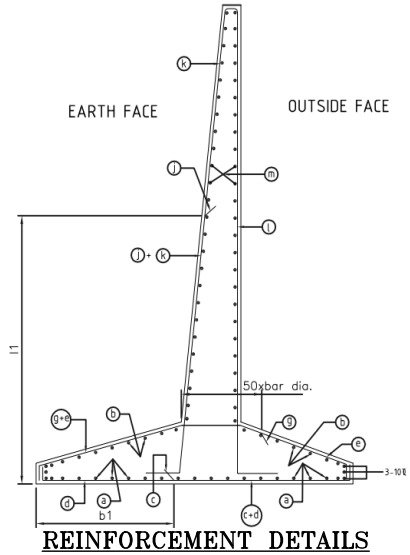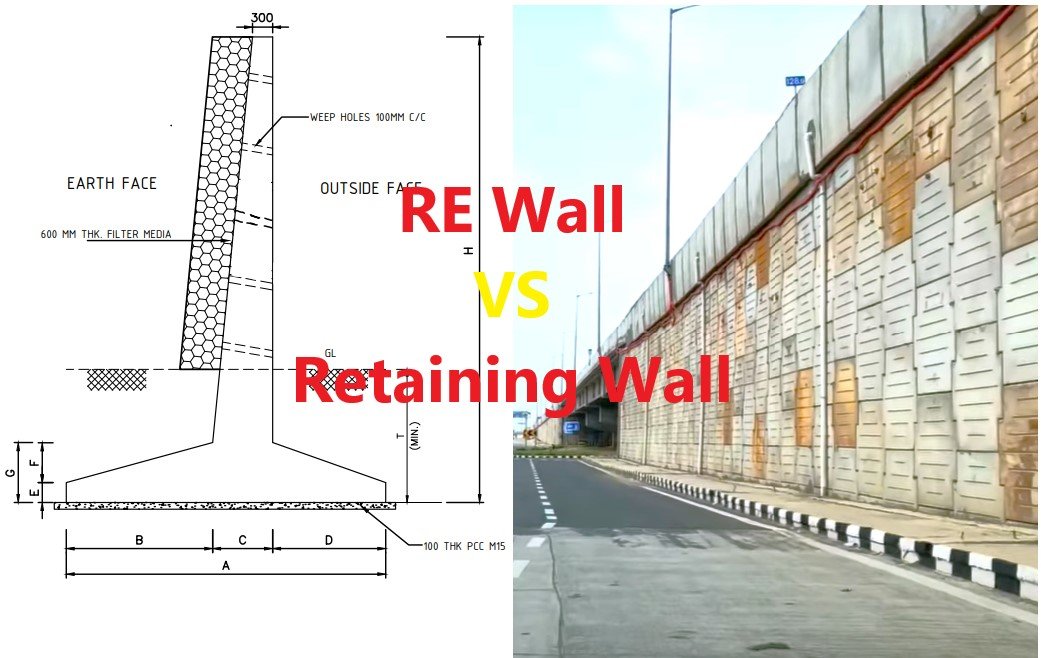In the realm of civil engineering, the utilization of various structural systems to retain soil and mitigate the forces acting on slopes has given rise to a spectrum of methodologies. Two prominent entities within this landscape are the Reinforced Earth (RE) Wall and the traditional Retaining Wall. While both share the overarching objective of stabilizing soil masses, their fundamental disparities lie in the approach to reinforcement, the construction methodology, and the resultant structural behavior.
Reinforced Earth Wall:
Reinforced earth walls represent a breakthrough in retaining structures, introducing a state-of-the-art paradigm in soil strengthening. Central to its distinctive attributes is the deliberate inclusion of reinforcement elements within the soil mass. Usually manifested as metal strips or grids, often made from materials such as galvanized steel, this strategic integration of reinforcement helps to significantly increase the tensile strength of the soil. The resultant composite material exhibits resilience against formidable lateral pressures and deformations, signifying a notable evolution in the science of geotechnical engineering.

Design Philosophy:
The design philosophy of an RE Wall is grounded in a comprehensive understanding of soil mechanics and the dynamic interaction between the soil and the reinforcement elements. Engineers meticulously analyze factors such as lateral earth pressure, surcharge loads, and seismic considerations to tailor the design to the specific demands of the project. This thoughtful approach allows for a high degree of adaptability, making RE Walls suitable for a diverse range of applications.
Versatility:
A distinguishing characteristic of Reinforced Earth Walls lies in their inherent versatility. The malleable design allows engineers to adeptly cater to diverse soil compositions, varying wall elevations, and disparate site conditions. This versatility renders them a compelling choice across a spectrum of applications, spanning highway infrastructure projects, commercial developments, and environmental endeavors. The versatility exhibited by Reinforced Earth Walls positions them as a favored solution for confronting intricate engineering challenges across a broad range of contexts.
Construction Methodology of RE Wall:
The construction methodology of a Reinforced Earth (RE) Wall is divided into distinct stages. Commencing with the preliminary site preparation, this phase encompasses excavation activities and the establishment of a robust foundation. Subsequently, reinforcement elements are judiciously situated within the soil, fostering optimal interaction between the material and the reinforcement components. Backfill material, chosen for its compaction attributes, is meticulously deposited and compacted in horizontal strata. The facing of the wall, frequently manifested through the installation of precast concrete panels or modular blocks, follows. The execution of this methodical construction process necessitates precision in reinforcement placement and scrupulous attention to the inherent properties of the materials employed.
Traditional Retaining Wall:
In contrast, a traditional Retaining Wall embraces a more conventional approach to soil retention. These walls are typically constructed using materials such as concrete, stone, or brick, without the incorporation of additional reinforcement elements within the soil mass. The stability of a traditional retaining wall relies predominantly on the mass of the wall material itself and the frictional resistance between the wall and the retained soil.

Design Philosophy:
While retaining walls come in various forms, including gravity walls, cantilever walls, and counterfort walls, the overarching design philosophy centers on utilizing the inherent strength of the chosen wall material. Engineers consider factors such as wall height, soil properties, and load conditions to design a structure that effectively resists lateral earth pressure.
Versatility:
Traditional retaining walls, while effective in certain applications, may exhibit limitations in terms of versatility. The design flexibility is somewhat constrained by the nature of the chosen wall material, and adjustments to accommodate specific site conditions may be more challenging compared to the adaptable nature of RE Walls.
Construction Methodology:
The Construction of a conventional retaining wall involves initial excavation operations and the establishment of a stable foundation, which mirrors the processes observed in the construction of reinforced earth (RE) walls. Notably, the absence of embedded reinforcements imparts a measure of simplicity to the construction procedures. The chosen wall material is built in a configuration that corresponds to the required design, and care is taken to ensure adequate backfill material compaction.
Key Differences:
- Reinforcement Approach: The pivotal contrast resides in the methodology of reinforcement. Reinforced Earth (RE) walls systematically integrate reinforcing elements into the soil matrix, increasing its tensile strength. In contrast, traditional retaining walls derive their stability from retaining soil due to the sheer mass and inherent structural properties of the selected wall material.
- Design Considerations: The design parameters for Reinforced Earth (RE) Walls necessitate a comprehensive comprehension of soil mechanics and the intricate interplay between the soil and the incorporated reinforcements. In contrast, conventional retaining walls predominantly emphasize the utilization of the inherent strength intrinsic to the selected wall material.
- Versatility: Reinforced Earth (RE) Walls exhibit an elevated level of adaptability, adeptly accommodating diverse soil compositions, variable wall elevations, and disparate site conditions. Traditional retaining walls, while functional, may be limited in terms of architectural versatility.
- Construction Complexity: The construction of RE Walls involves additional considerations for the proper placement of reinforcement elements and meticulous backfill compaction. Traditional retaining walls may have a relatively simpler construction process.
Conclusion:
In conclusion, while both Reinforced Earth Walls and traditional retaining walls serve the common purpose of retaining soil and mitigating lateral forces, their divergence in approach and application is profound. The sophistication of RE Walls lies in the strategic integration of reinforcements within the soil mass, offering enhanced adaptability and structural performance in diverse engineering scenarios. The selection between these methodologies hinges on project-specific requirements, soil conditions, and the nuanced considerations of civil engineering design. As the field evolves, the discerning engineer must weigh these factors judiciously to determine the most suitable solution for a given context.

